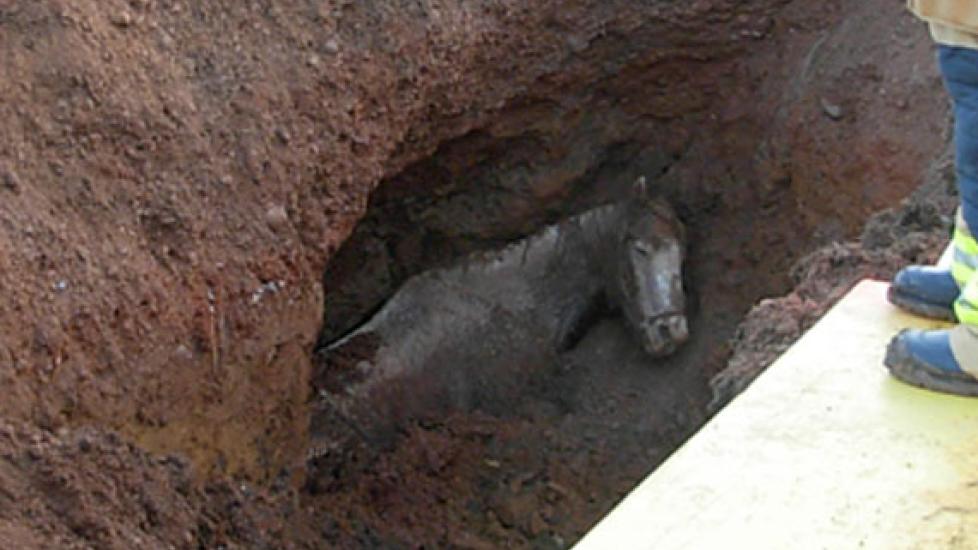How Do You Save a Horse From a Sinkhole? Very Carefully, It Turns Out
A few winters ago, it was quiet at the office, which is not unusual in the colder months. Few babies are being born, and both people and their animals are tucked away from the cold, hunkering down to wait out the snow until spring, when all hell breaks loose.
As I was beginning to pack up my things to head home for the day, my boss called, asking me to stop by a client’s farm to check out a horse that reportedly was stuck in a mud hole.
“That’s all I know,” she said. I could hear her shrugging over the phone. “Just go check it out.”
As it turns out, “stuck in a mud hole” was the biggest understatement of the year. Turning down the country lane to the farm, I screeched to a halt. Two fire engines took up the entire street and a police car diverted traffic. As the sun set, flashing lights lit up the sky.
Thinking this was perhaps something going on with a neighbor, I pulled over close to the driveway and hopped out to find my client and her horse. I was greeted at the end of the driveway by a local firefighter, who also happened to be a client of mine. “Glad you’re here,” he said. “We’re trying to figure this out.”
As we walked into the pasture, I strained to find the alleged horse in the mud. Exactly what kind of mud hole causes the entire local fire department to arrive on the scene? Turns out, this was way more than a mud hole. This was a sinkhole and the horse had fallen into it — the earth essentially swallowed him up. Fifteen feet into a newly formed earthen cave, the horse — an elderly white spotted gelding named Smokey — had his back legs buried. Lying somewhat sternal, he was alert and somehow not in a panic. But time was of the essence. It was cold out. Soon he would become hypothermic. The circulation to his back legs could very well be dwindling. He might even have fractures. I wasn’t sure he would make it out alive.
Heading toward the sinkhole to assess the horse’s health status, the firefighter grabbed my arm. “You can’t go in there,” he said. The sides of the sinkhole were too unstable. The whole thing could come crashing down, burying me in the process, along with the horse. Over the next two hours, the fire crew worked on stabilizing the walls of the sinkhole and constructing a pathway down into the hole. At one point, they allowed me to go in, winched with a rope around my waist in case they had to yank me out. They also insisted I wear one of their heavy-duty jackets and a helmet.
Reaching Smokey, I still couldn’t tell if his buried legs were broken, but he appeared stable. I administered some warm IV fluids and then was pulled back out. By this time, the local horse rescue squad arrived on the scene. We are lucky in our area to have such a team, which consists of individuals with specific training on large animal rescue operations. They travel to hurricane-ravaged locales and trailer accidents, pulling mangled horses from debris. They had equipment such as tethers, ropes, and hoists, and knew how to use them.
After a few more hours, the fire department deemed the hole stable and, together with the rescue team, had a well-strategized plan for “Evacuation Horse.” I could only stand and watch, and to my amazement it worked. Well-placed ropes and even, slow pressure from multiple people produced a horse from what seemed like the depths of the earth. After a few seconds of holding our collected breath to see if he could actually stand, we sighed with relief as he took slow, wobbly steps. Nothing seemed to be broken.
By now, it was very late. All the lights and emergency vehicles had gathered the attention of the locals and there was a group of gawkers at the gate. We put a blanket on the horse and I gave him more IV fluids and a warm bran mash to eat. He looked exhausted. All the emergency personnel were exhausted. I was elated. To this day, I still don’t really know how they all pulled it off.
Before everyone left for the night, I overheard the fire department instruct my client to fence off the area where the sinkhole was located. The area encompassed about half of her pasture. Through various side conversations I learned her land was close to a quarry and prone to sinkholes. In fact, a cow of hers fell through a smaller one a few years ago. Thinking it might be time to move her entire farm, I drove home for the night, watching the emergency lights dim in my rearview mirror, musing over the understatement of the year.

Dr. Anna O'Brien
